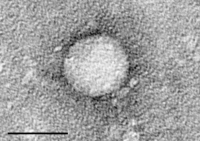
Photo from wikipedia
The outcomes of biological control programs can be highly variable, with natural enemies often failing to establish or spread in pest populations. This variability has posed a major obstacle in… Click to show full abstract
The outcomes of biological control programs can be highly variable, with natural enemies often failing to establish or spread in pest populations. This variability has posed a major obstacle in use of the bacterial parasite Pasteuria penetrans for biological control of Meloidogyne species, economically devastating plant‐parasitic nematodes for which there are limited management options. A leading hypothesis for this variability in control is that infection is successful only for specific combinations of bacterial and nematode genotypes. Under this hypothesis, failure of biological control results from the use of P. penetrans genotypes that cannot infect local Meloidogyne genotypes. We tested this hypothesis using isofemale lines of M. arenaria derived from a single field population and multiple sources of P. penetrans from the same and nearby fields. In strong support of the hypothesis, susceptibility to infection depended on the specific combination of host line and parasite source, with lines of M. arenaria varying substantially in which P. penetrans source could infect them. In light of this result, we tested whether using a diverse pool of P. penetrans could increase infection and thereby control. We found that increasing the diversity of the P. penetrans inoculum from one to eight sources more than doubled the fraction of M. arenaria individuals susceptible to infection and reduced variation in susceptibility across host lines. Together, our results highlight genotype‐by‐genotype specificity as an important cause of variation in biological control and call for the maintenance of genetic diversity in natural enemy populations.
Journal Title: Evolutionary Applications
Year Published: 2022
Link to full text (if available)
Share on Social Media: Sign Up to like & get
recommendations!